Canopus Toms And Bass Drums “Designed To Be Different”
HITS
Thin shells provide good resonance
Reinforcement rings provide strength
Bearing-edge profiles are matched to drum type to eliminate high-pitched overtones
MISSES
Floor toms may be too dry for some tastes
by Rick Mattingly
A short time back I reviewed the solid-shell Zelkova snare drum made by a small Japanese company called Canopus. It was a unique drum in terms of its sound and construction.
Canopus has also offered a variety of metal and ply-shell snares for quite a while. But now the company has entered the US market with toms and bass drums to create complete drumkits.
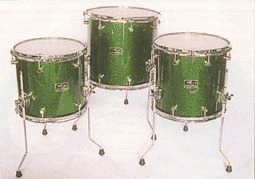
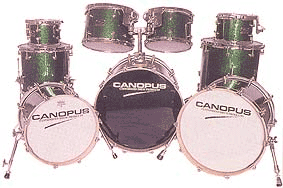
Ring Around The…Drum
In the 1960s and ’70s, reinforcement rings in drumshells were the norm (with the exception of Gretsch). But in the 1980s several drum-makers besides Gretsch started offering shells with no reinforcement rings, claiming that a quality drumshell doesn’t need them. Pretty soon, reinforcement rings became the exception rather than the rule.
Canopus has taken a fresh look at the situation and decided that reinforcement rings are desirable in toms and bass drums. But the rings they use are quite thin. While they do add strength to the shell where it’s most needed, they are also designed to enhance the vibrational capabilities of the shell by addressing a basic conflict in drum-making.
It is generally agreed that the thinner a shell, the more resonance the drum will have and the warmer the tone will be. But if the shell is too thin, the drum won’t have the strength it needs to withstand the tension of the heads and to stand up to forceful playing.
Because they use reinforcement rings, Canopus is able to start with a thin shell. From there, they use nine different “formulas” of shell plies + ring plies + ring width to create their eleven tom and bass-drum models.
The rings vary in thickness from 3-ply to 5-ply, increasing the shell thickness at each end of the drums by 60-100%. The rings also vary in width from 1/2″ on the smallest rack tom to 1.25″ on floor toms and bass drums (except the 12×15 bass drum, on which the ring is only 1″ wide). Canopus explains all of this by comparing the shell to a guitar string and the reinforcement ring to a guitar bridge. If you’re curious, read all about it at the company’s Web site, www.canopusdrums.com.
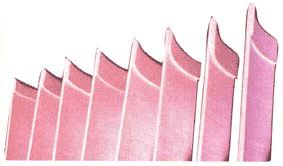 Size and thickness of reinforcement rings varies with the size of each drum.
Size and thickness of reinforcement rings varies with the size of each drum.
The company also matches the bearing edge to the type of drum. Rack toms, floor toms, and bass drums each feature edges with slightly different profiles. According to the company, this is done to control high-pitched overtones so that no muffling is necessary.
This all sounds good in theory, but how do the drums sound to the ears? We’ll discuss them by category.
Bass Drums
We received bass drums in all four sizes that Canopus makes. I started with the 15×22 drum, and immediately came to the conclusion that it was everything a bass drum should be. It had plenty of punch, but it also had a warm tone. The sound was dry enough that I didn’t feel the need for any additional muffling, yet it had enough resonance and sustain to make it sound rich and full.
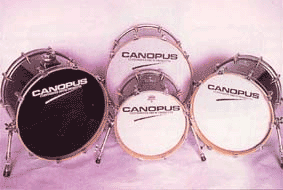
he 15×20 drum was equally impressive. Because of its diameter, it favored a slightly higher pitch, but it still had plenty of bottom. And while it understandably didn’t produce quite as much volume as the 22″ drum, it had more power than I expected. As such it would probably be the best choice for those needing a drum that’s strong enough for rock but that wouldn’t overpower pop or even jazz settings.
Having played quite a few jazz gigs over the years, l’ve heard many 18″ bass drums that sound more like large toms. (You might call them “baritone” drums.) But the Canopus 14×18 bass drum got a credible bass sound with good punch and a warm tone. In fact, it compared favorably to some 20″ bass drums l’ve worked with.
If an 18″ bass drum is a “baritone,” then you’d have to call a 15″ bass drum a “tenor.” Anyway, that was my take on the Canopus 12×15. Tuning it as low as possible without the heads flapping, I was reminded of the way Elvin Jones tunes his 18″ bass drum. l’ve heard other jazz drummers use similar tunings. So the Canopus 12×15 drum might find favor with drummers who want to keep their “bass” drum above the range of an acoustic bass player.
This drum could also work for those who pad their bass drums so as to get a dry “thud” rather than a “boom.” Of course, even a thud has some pitch to it, and there is no way that this drum will ever be mistaken for a 22″ or even a 20″, On the other hand, it could be quite adequate for triggering applications, and it certainly is easy to carry compared to a traditional bass drum. I’d suggest a drier batter head than an Emperor, though…such as a Pinstripe.
Floor Toms
One of the company’s stated goals is to reduce “undesirable” high-pitched overtones by shaping the bearing edge. They’ve certainly achieved it with the floor toms, although from prior experience with floor toms on which the shell depth is less than the head diameter, l’m not sure all the credit can be given to the bearing edge. Nevertheless, all three drums had a considerably dry sound. But they also had quite a bit of sustain, which you don’t always get with such a narrow range of overtones.
Of the three drums, the 12×13 had the best tone, with the 13×14 a close second. But try as I might to tune, the 15×16 remained dry to the point of sounding brittle. This is not the drum for those who like boomy floor toms that sound like you’re playing in a bathtub. But for those who prefer a contained sound with strong attack and good sustain, all of the Canopus floor toms are worth investigating.
Rack Toms
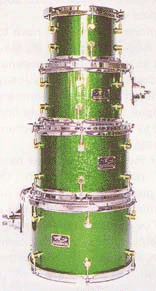
All of the rack toms we reviewed were fitted with RIMS suspension mounts. They shared the basic characteristics of the floor toms in terms of having a dry, focused sound with a lot of sustain. But all four of the rack toms had warmer, rounder tones than any of the floor toms. They also sounded good over a larger pitch range.
All Together Now
When I started playing various combinations of tom-toms and floor toms, I was impressed at how well they all worked together. I’ve played many kits in which the rack toms sounded fine in their own right, as did the floor toms. But when I started playing “around the kit” patterns, it sounded as if I had changed drumsets when I went from one type of tom to the other. Not so here. Even though the rack toms had slightly richer tonal qualities than the floor toms, the overall sound of the drums was harmonious. Had the floor toms been any “boomier,” they would have overpowered the small toms.
If I were only using two toms, I wouldn’t match the 6.5×8 rack tom with the 15×16 floor tom, since the optimum pitches for each drum wouldn’t make a good match. Nevertheless, in terms of overall timbre, they sounded as if they belonged to the same drumkit. So it would be pretty safe to mix and match sizes to fit one’s personal preferences.
Conclusions
Canopus drums feature quality workman-ship, and they are professional in sound and appearance. But they’re not just a carbon-copy of all the other drums on the market. What sets them apart is that elusive quality called “personality.” The dry sound of Canopus drums won’t fit everyone’s taste or playing style, but then neither does the K” style of hand-hammered cymbals.
Buddy Rich said that the best thing you can say about any drummer is that he has his own sound. Perhaps that same philosophy should be applied to drums themselves, If you agree, you should check out Canopus drums. They’re available through various dealers in the US, and can also be ordered direct from the company’s Web site: www,canopusdrums.com.
Drumheads:
18″, 20″, and 22″ bass drums fitted with Remo PowerStroke 3 batter heads with Falam Slam impact pads. 18″ and 22″ drums fitted with white coated front heads with Canopus logos; 20″ drum fitted with smooth black front head, 15″ drum fitted with Remo Emperor batter and coated white front head. All toms fitted with Remo white-coated Ambassador heads on both sides.
Shells:
100% American maple
20″ and 22″ bass drums: 6-ply, 5/32″-thick.
All other drums: 5-ply, 1/4″-thick.
Finishes:
Standard colors: sparkles in red, blue. green, black, silver, gold, and champagne, solid black. Custom colors (10% extra charge): black oyster, white marine sparkle, and black diamond.
Modern Drummer June 2001

